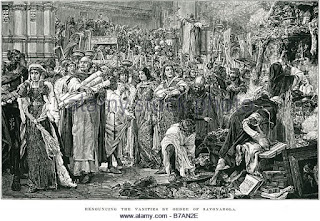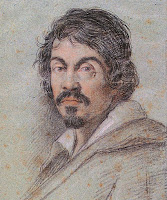Mystic Nativity
The
crowds watched the thick black smoke rising up into the Florentine sky. They
watched with a sense of self righteousness as the flames turned irreplaceable
manuscripts, ancient scriptures, antique and modern paintings, priceless
tapestries, as well as mirrors, and musical instruments into a heap of smoldering ash.
It's the 7th of
February 1497. This is the evening of the notorious 'Bonfire of the
Vanities'. Among the crowds is Florence's celebrated Renaissance master Sandro
Botticelli, who burned several of his own paintings that evening.
The 'Bonfire of the Vanities' was
orchestrated by the charismatic and fanatical Dominican monk, Girolamo Savonarola,
who was known for his apocalyptic sermons. After the ruling Medici dynasty was
overthrown in 1494, Savonarola effectively had the city of Florence captivated, both politically as well as spiritually. Florence, at the time, was a city
of extreme wealth. The citizens were patrons of the arts and culture. On that
fateful evening Savonarola called upon the people of Florence to burn all
objects associated with vanity, temptation and sin. Sandro Botticelli was among
his most ardent of followers.
It is against this backdrop and the fervent speech Savonarola delivered on the eve of
Christmas in 1493, that Sandro Botticelli created the beautiful painting 'Mystic Nativity'.
This 42.7 inches by 29.5 inches, oil
on canvas painting was created in Circa 1500-1501 and was probably
commissioned by a wealthy patron in Florence.
The 'Mystic Nativity' depicts a scene
of joy and celebration of earthly and heavenly delight. This is the only
painting that Botticelli ever signed. Along with his signature it has an
inscription in Greek within a gold band right at the top of the painting. This is very unusual for a nativity painting. The inscription predicts Christ's
Millennium, or second coming, as stated in the Biblical text.
Heaven opens in a great golden dome.
The gold symbolizes the untarnished, unchanging nature of heaven as gold
doesn't tarnish like silver. Botticelli added the gold by using an
adhesive layer made of oil mixed with resin, and then just patted it down
on to the surface of the canvas which made it shine like a jewel. He learnt
this craft when he apprenticed with a goldsmith as a boy.
We see a circle of twelve angles
dancing below the golden dome. They represent the twelve hours of the day and
the twelve months of the year. The angles are dressed in robes representing their virtues. 'Faith' in white, 'hope' in green and 'charity' in red. They hold olive branches, the traditional symbols of peace. Below
them we see three angels dressed in the same symbolic colors of faith, hope and
charity sitting on the roof of the manger reading a book. It is believed that
through this Botticelli wanted to indicate to the viewer that his painting has
a deeper meaning which needs to be read into.
 At the center of the painting we see
the holy family who are depicted much larger than the other figures to
emphasize their importance. Mary adores the baby Jesus who is lying on a white
sheet which reminds the viewer of the shroud in which his body
will be wrapped one day.
At the center of the painting we see
the holy family who are depicted much larger than the other figures to
emphasize their importance. Mary adores the baby Jesus who is lying on a white
sheet which reminds the viewer of the shroud in which his body
will be wrapped one day.
The manger in the background behind
the virgin, foreshadows the tomb in which Christ will be buried. We see Joseph who appears to be resting. On the right side are the shepherds in rustic
clothing who have come to worship Christ on the day of his birth. On the left
are the wise men, they carry no gifts and are dressed simply to stress humility
and simplicity in the Christian lifestyle.
The foreground shows the second
coming of Christ, the 'Last Judgement'. Here we see the same three angels
embrace three men, seeming to raise them up from the ground. They hold scrolls
which proclaim in Latin "Peace on earth to men of goodwill".
Behind them we can see seven devils,
symbolic of evil fleeing to the underworld, some impaled on their own weapons.
Through this painting Botticelli is asking the viewer to think not only of
Christ's birth but also of his return.
The 'Mystic Nativity' is painted on
canvas. Normally Botticelli would have used a wood panel to paint on. Perhaps, keeping in mind the social, religious and political environment of the time, he feared that the painting may need to be rolled up and hidden.
Savonarola's excesses earned him the
disdain of Pope Alexander VI. He was eventually excommunicated from the church. In 1498 the disgraced Savonarola was burnt on the stake.
Botticelli died twelve years later in 1510. The 'Mystic
Nativity' remained hidden for over three centuries until it was bought by an
English art collector and taken to England. It finally emerged from obscurity and was displayed in Manchester in 1857.
Today it can be seen at the National
Gallery in London.
References: National Gallery, London.








Comments
Post a Comment